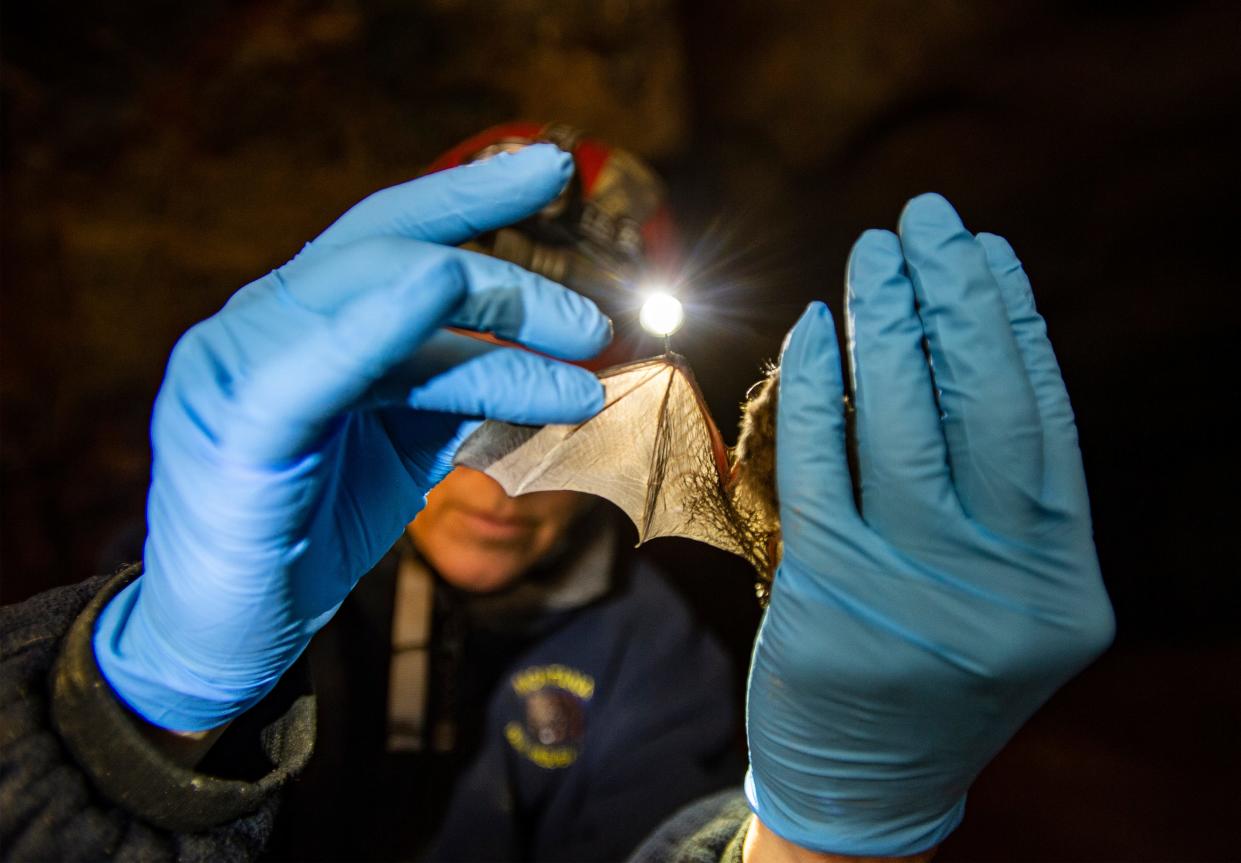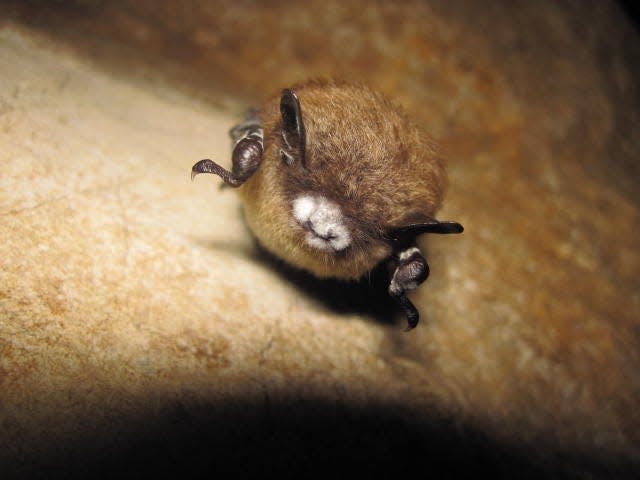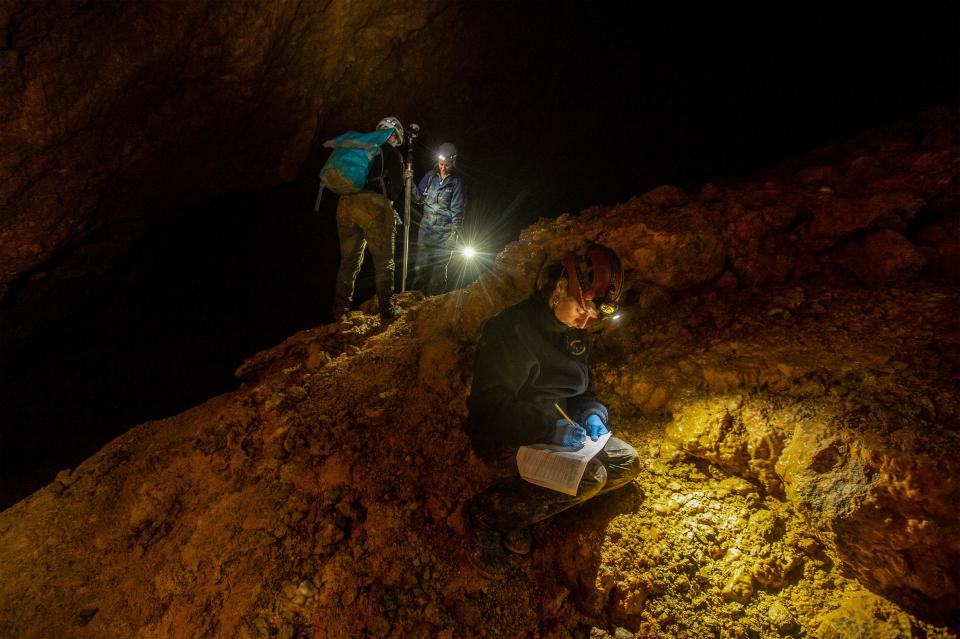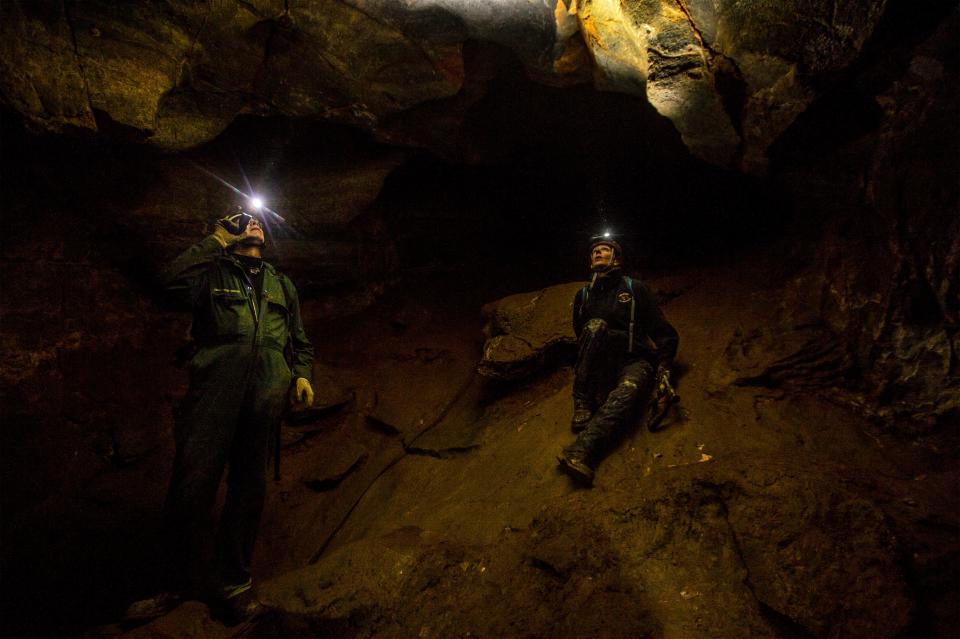Montana bats in crisis as white-nose syndrome fungus detected in central Montana

Wildlife biologists with the Montana Department of Fish, Wildlife and Parks (FWP) have recently detected the presence of the fungus that causes white-nose syndrome (WNS) at Lick Creek Cave in the Little Belt Mountains of Cascade County. It is the first confirmed detection of WNS in Cascade County and has the potential for devastating effects on Montana bats.
“We did not see the fungus associated with white-nose syndrome on the bats in Lick Creek Cave,” said Shannon Hilty, a non-game wildlife biologist for FWP, “but we did find the fungus inside the cave, and once we detect it, we typically find bats infected with the disease the following year.”
White-nose syndrome is a disease that causes a powdery white fungus to grow on the skin of hibernating bats. The fungus, Pseudogymnoascus destructans, attacks bare skin on the face and forearms of bats. The irritation arouses bats from winter hibernation to groom the affected areas, causing the mammals to exhaust the stored fat reserves they need to survive. Symptoms worsen over time, wearing holes in the bats’ wings.
“It would be like a really bad case of athlete’s foot,” said Dan Bachen, senior zoologist with the Montana Natural Heritage Program. WNS does not directly affect humans, pets, livestock or other wildlife.

Spread of fungus that causes WNS across the US
Since the fungus that causes WNS first appeared in New York state in 2006, the disease has spread rapidly west, killing an estimated 6.7 million bats in 40 U.S. states and eight Canadian provinces.
White-nose syndrome was first detected in Montana in 2020 at Azure Cave in the Little Rocky Mountains northeast of Lewistown. A survey two years later found that 98-percent of that cave’s bats had either died or moved to a different location. FWP has found the fungus that causes WNS in four of Montana’s 15 bat species.
Hilty said the emergence of WNS at Lick Creek Cave was “only a matter of time.”
“We’ve been slowly watching the spread of WNS since 2006/2007,” Hilty said. “I was by no means surprised to learn that Lick Creek Cave was positive, since it does get used by bats, but I was still really bummed out about the confirmation. Some populations of bats in the east have seen 90-100% declines due to WNS. When you study and love bats, and you understand how important they are to ecosystems and the economy, that’s a pretty disappointing fact to come to terms with.”
To view a map showing the progression of white-nose syndrome in Montana, check out www.whitenosesyndrome.org/where-is-wns.
Discovery of the fungus in Montana's Lick Creek Cave
The presence of the fungus in Lick Creek Cave is especially devastating because Lick Creek is one of only eight caves in Montana supplying refuge to more than 50 roosting animals. Bats also roost at bridges, cliff crevasses, buildings and in bat houses, but these are primarily summer roosts, not places where they hibernate. In some small respect this low concentration of hibernating bats may offer an advantage to controlling the spread of the disease.
“In eastern North America many bat species hibernate together in large numbers of thousands to tens of thousands, so you can imagine how bat-to-bat transmission would happen quickly,” Hilty explained. "However, in Montana and the Rocky Mountain west, our bats do not appear to be hibernating in caves in these large numbers, which begs the question, where the heck are they?”
“We assume they’re using features such as buildings, talus slopes, and cliffs, but we are working to get a better understanding of this,” she continued. “This could be good news — perhaps the fungus doesn’t survive and spread the same way it does in eastern North America in some of these nontraditional hibernacula either due to differences in the environment or in bat behavior.”
“We don’t yet have a good understanding of how bat populations will be affected by WNS in Montana,” said Kristina Smucker, nongame wildlife bureau chief for FWP. “So, in addition to our disease surveillance efforts we are also placing acoustic detectors to record bat calls and monitoring bats at summer roost sites.”

How destruction of bat colonies affects the ecosystem
The destruction of bat colonies in North America is not simply a concern for wildlife biologists, conservationists and people who just enjoy seeing bats. Bats are an important component of the ecosystem and economy of the state and are also a part of the unique biological diversity of Montana.
“A little brown bat can eat 1,200 mosquitoes in an hour,” Smucker noted. “Bats are tremendously important for keeping insect populations in check — they help protect crops and timber from flying insect pests, so we are very concerned about our bat populations and the impacts of this disease as we watch it spread across Montana.”
Not all species of bat are equally susceptible to white-nose syndrome. Hilty said that seven of Montana’s bat species are of special concern.
“Based on what researchers have observed in other states, we think that Montana’s Little Brown Myotis and Northern Long-eared Bats might see some of the biggest population declines,” she said. “However, several other Montana species are susceptible to the disease: big brown bat, fringed myotis, long-legged bat, western long-eared bat, and Yuma myotis. In other states, several species that occur in Montana have been observed with the fungus but without diagnostic symptoms of WNS: eastern red bat, silver-haired bat, Townsend’s big-eared bat, and western small-footed myotis.”
Treating white-nose syndrome
Options for treating white-nose syndrome are limited and largely experimental. Disease ecologists and wildlife research biologists are investigating the possibility of placing ultraviolet light near roosting entrances, applying anti-fungicide on the floors and walls of caves infected with WNS, and perhaps dusting bats with a vaccine in a way so that their grooming would effectively dose them. Hilty said FWP is exploring these options at Lick Creek Cave.
“One of the big roadblocks we’ve had in the west is trying to determine what we would treat,” she explained. “The majority of Montana’s bats are not hibernating in caves and mines, so it wouldn’t be as easy as treating these features alone. However, it’s possible that we could treat select hibernacula, such as Lick Creek Cave, and administer vaccines in early spring when bats start showing up at some of these other features like bat boxes and buildings.”
For the immediate time at hand, Montana Fish, Wildlife and Parks has closed public access to Lick Creek Cave.
"We are closing access to Lick Creek Cave in alignment with state guidance for controlling white-nose syndrome," said District Ranger Helen Smith. "We will also be looking at closing neighboring caves to help mitigate the collapse of additional bat colonies.”
Questions on the cave closure can be directed to the Belt Creek-White Sulphur Springs Ranger district offices in Neihart, 406-236-5100, or White Sulphur Springs 406-547-3361.

What can the public do?
Cavers, climbers and recreationists that visit areas with roosting bats should remove dirt and mud from shoes, gear and clothing before leaving a site; bag these items to take home; and clean items promptly. People that visit multiple areas where bats might reside should follow decontamination protocols to help stop the spread of WNS: www.whitenosesyndrome.org/static-page/decontamination-information.
Anyone who sees a dead or sick bat, or group of bats, or finds bats in unexpected places, should not handle them, but rather call a local FWP office for further guidance.
“Like other wildlife, bats may get sick or die for a variety of reasons,” said Emily Almberg, wildlife disease ecologist for Montana FWP. “We are particularly interested in investigating clusters of dead bats or bats that are found dead during the winter or early spring, as that may indicate WNS being the cause.”
People can report these discoveries to the FWP Wildlife Health Lab in Bozeman at 406-577-7882, or they can contact a biologist at their nearest FWP office.
For more information on white-nose syndrome, visit www.whitenosesyndrome.org/. For more information on Montana’s bats visit fieldguide.mt.gov.
This article originally appeared on Great Falls Tribune: Deadly white-nose virus detected in Montana's Lick Creek Cave

